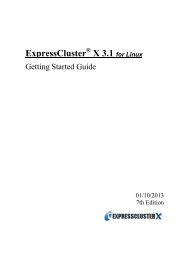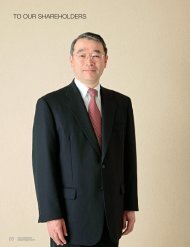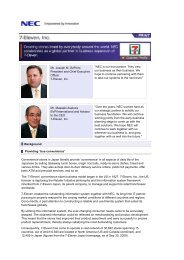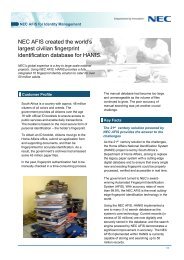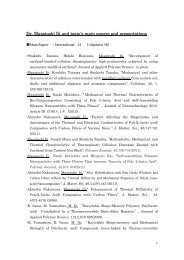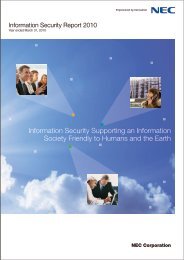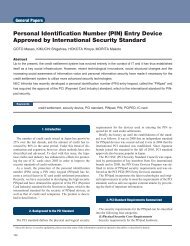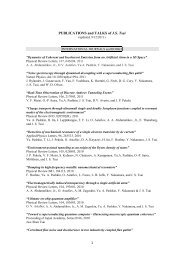How well can Humans Coexist with the Cyber World? - Nec
How well can Humans Coexist with the Cyber World? - Nec
How well can Humans Coexist with the Cyber World? - Nec
- No tags were found...
You also want an ePaper? Increase the reach of your titles
YUMPU automatically turns print PDFs into web optimized ePapers that Google loves.
Panel Discussion<strong>How</strong> <strong>well</strong> <strong>can</strong> <strong>Humans</strong> <strong>Coexist</strong> <strong>with</strong> <strong>the</strong> <strong>Cyber</strong> <strong>World</strong>?The objective of this panel discussion is to explore <strong>the</strong> coexistence of <strong>the</strong> real and cyber worlds bydiscussing how <strong>the</strong> information systems that are growing in complexity and immensity will continue toevolve in <strong>the</strong> future, and how humans should utilize those information systems in <strong>the</strong>ir everyday lives.Panelists discuss <strong>the</strong> <strong>the</strong>me in depth while exchanging opinions based on <strong>the</strong> different perspectives ofsystem engineering, social science, and information technology.Hirotada OhashiProfessor, Department of Systems Innovation,<strong>the</strong> University of TokyoIkuyo KanekoDean & Professor,Graduate School of Media and Governance,Keio UniversityTakemitsu KunioAssociate Senior Vice President and Executive GeneralManager of Central Research Laboratories,NEC CorporationIT will evolve along 3 pillarsModerator: The <strong>the</strong>me of this discussion is “Human<strong>Coexist</strong>ence <strong>with</strong> <strong>the</strong> <strong>Cyber</strong> <strong>World</strong>”. First, I would like to startby asking your opinions on what sort of changes you think willhappen in <strong>the</strong> future.Kunio: Having heard some very interesting thoughts of myfellow panelists, I would like to follow-up by offering my viewson <strong>the</strong> technological trends that we might expect in <strong>the</strong> future.As I mentioned during my opening speech, <strong>the</strong> IT until nowwhich is epitomized by C&C has evolved along <strong>the</strong> twin pillarsof systemization and digitalization. But from now on, it looks asif we need to consider 3 pillars. The first is “Symbiosis”; <strong>the</strong>pillar of coexistence and co-creation between humans and IT.The second is “Dependability”; <strong>the</strong> pillar that protects <strong>the</strong> safetyand security of people. And <strong>the</strong> third is “Ecology”; <strong>the</strong> pillar thatseeks to balance <strong>the</strong> advancement of society <strong>with</strong> protection ofNEC TECHNICAL JOURNAL Vol.4 No.1/2009 101
Panel Discussion<strong>How</strong> <strong>well</strong> <strong>can</strong> <strong>Humans</strong> <strong>Coexist</strong> <strong>with</strong> <strong>the</strong> <strong>Cyber</strong> <strong>World</strong>?Fig. New directions of <strong>Cyber</strong> technologies to be implemented.<strong>the</strong> global environment and ecosystems. Next, please allow meto elaborate on <strong>the</strong> activities that NEC has already initiated in<strong>the</strong>se areas.As an example of “Symbiosis”, we are aiming atstreng<strong>the</strong>ning our HI (Human Interface) technology. We havealso commenced international collaborative research onintegrating <strong>the</strong> fields of natural science and psychology or socialscience, <strong>with</strong> <strong>the</strong> development of HI components at its core. In<strong>the</strong> next category, “Dependability”, developing a robust systemframework to avoid service downtime, security technologies toprotect personal lives, and management technologies fornetwork autonomous systems will become crucial. And in“Ecology”, <strong>the</strong>re is our low power consumption server that won<strong>the</strong> Minister of Economy, Trade and Industry Award at <strong>the</strong>“Green IT Awards 2008”, as <strong>well</strong> as our efforts in promoting <strong>the</strong>use of bioplastics to lessen our dependence on fossil fuels. Ibelieve that when <strong>the</strong>se three factors are joined by a change ofpeople’s way of thinking, <strong>the</strong> birth of “human- andearth-friendly technologies” will begin in earnest.Mentality and organization that shakes off previous misconceptionsOhashi: I agree that <strong>the</strong> coexistence and integration of <strong>the</strong> realand cyber worlds will progress to a greater extent in <strong>the</strong> future.Not limited to just technologies, we are seeing that varioussectors such as education and medicine which have supportedsocial systems are becoming increasingly borderless. In thistrend, new issues have arisen including <strong>the</strong> consolidation andusage of dispersed knowledge, <strong>the</strong> most effective distribution ofresources, as <strong>well</strong> as various latent vulnerabilities.<strong>How</strong>ever, are <strong>the</strong>se facts really being understood? I believethat today’s intellectuals suffer from several misconceptions.First is <strong>the</strong> belief that “every problem has an answer”. There isno such thing as a “correct answer” or “almighty prescription”for problems such as social security and bullying. Second is <strong>the</strong>belief that “it is necessary to know all and control all”. I’ve beentold a story about an economic bureaucrat during <strong>the</strong> SovietUnion era that visited a bakery in London, asking in disbelief“how is it that <strong>the</strong>y know how much bread will be consumed perday when nobody is controlling it, and who hands it out whennobody has any plan?” Fact of <strong>the</strong> matter is, it is impossible toknow and to control everything. Yet ano<strong>the</strong>r misconception is<strong>the</strong> assumption that “more precise knowledge leads to moreaccurate belief”. The field of physics has what’s called <strong>the</strong>“uncertainty principle”. So likewise, in social systems, perhaps<strong>the</strong> subject may sometimes become more obscured as moreknowledge is gained and <strong>the</strong> perspective of <strong>the</strong> observer getscalled into question.In order to create 21st century type organizations, it is firstnecessary to shake off <strong>the</strong>se erroneous misconceptions. Variousconditions are changing. For example, interactions <strong>with</strong>in andoutside <strong>the</strong> company are rapidly growing. This mutualfunctionality <strong>the</strong>n refines and expands innovations. What’smore, <strong>the</strong>re arises a need to prepare for a wide variety ofuncertainties. Since decision-making must be justified in termsof accountability, it is necessary to rely on more sophisticatedprocesses. And it will be necessary for organizations to bealways open and evolvable.Kaneko: That story about <strong>the</strong> London bakery was mostinteresting. I believe it’s a type of automatic mechanism that’spart of <strong>the</strong> market. <strong>How</strong>ever, as <strong>with</strong> <strong>the</strong> recent collapse of <strong>the</strong>financial system, we’ve begun to see that market principles arenot always versatile enough. In <strong>the</strong> field of medicine also, it maybe possible to accommodate changes at each occurrence, but <strong>the</strong>overall system starts to break down. Perhaps it’s pushing <strong>the</strong>limits of <strong>the</strong> autonomous distribution system model in caseswhere <strong>the</strong> scale has become too big. Maybe solutions would bepossible if it were a system <strong>with</strong> enhanced robustness?102
Ohashi: In <strong>the</strong> medical services as <strong>well</strong> as educational fields,today’s complex problems <strong>can</strong>not be solved by some leader orgenius. I think our current times call for all sorts of people toprovide diverse ideas, try new things and move <strong>the</strong>m along. It isthis type of improvement effort that will eventually yieldinnovations.Kunio: I have a question for <strong>the</strong> two of you. In our current agewhere systems are becoming ever more complex both in termsof quantity and quality, how should we in <strong>the</strong> informationtechnology field approach <strong>the</strong> situation?Ohashi: I think a good example of a system where robustnessfunctions properly is <strong>the</strong> human body. It contains self-healingcapabilities such as <strong>the</strong> immune system, and is constantlyworking to balance itself out. This may not be <strong>the</strong> only answer,but perhaps if we think of <strong>the</strong> human body comparing <strong>with</strong>society, <strong>the</strong>n we <strong>can</strong> also use similar models when consideringinformation technology and information infrastructures.Kaneko: In <strong>the</strong> empirical test project of telemedicine we areengaged in <strong>the</strong> Co-Mobility Project I mentioned in my lecture, ithas been recognized that a monthly 30-minute or soconversations <strong>with</strong> a doctor followed up regularly by staffmembers a few times a week, over a teleconference over <strong>the</strong>internet is quite effective in improving vital data of patients. It isobvious that deepening <strong>the</strong> mutual trust between doctor andpatient has a positive effect. So in <strong>the</strong> medical field, which hadbeen bound by <strong>the</strong> traditional doctrine of meeting face to face,new possibilities are arising. In o<strong>the</strong>r words, <strong>the</strong> soundapplication of information technology <strong>can</strong> increase <strong>the</strong>likelihood of social innovations occurring.Expectations for technology that will raise<strong>the</strong> human connection to cultural levelsModerator: Now I would like to change <strong>the</strong> subject and ask foryour thoughts on <strong>the</strong> relationship between individuals and <strong>the</strong>cyber world.Ohashi: There is no doubt that fur<strong>the</strong>r improvements in <strong>the</strong>digital infrastructure will increase convenience. Newlyanticipated technologies for <strong>the</strong>se improvements may include,for example, making selection among large quantities ofunreliable information, clarifying <strong>the</strong> role and mechanism ofsocial media such as Internet bulletin boards, controllingfreeriders, and increasing <strong>the</strong> potential of multiprocessing. I believethat <strong>the</strong> relationship between <strong>the</strong>se information technologies and<strong>the</strong> ability of individuals to use information is a“co-evolutionary” one, in which both continue to evolve whileacting upon each o<strong>the</strong>r.Kaneko: The relationship between humans and <strong>the</strong> cyber worldhas changed dramatically over <strong>the</strong> last 10 years due to <strong>the</strong>increased functionality and proliferation of <strong>the</strong> Internet andmobile phones. To put it simply, it has become easier for peopleto connect to various information, as <strong>well</strong> as connectinginformation to each o<strong>the</strong>r. This is convenient, but also risky. Soit is important that we fully understand <strong>the</strong> existence of thoserisks, and as I pointed out in my speech earlier, developrelationships where people are able to help each o<strong>the</strong>r. I considerthat “people being connected to each o<strong>the</strong>r, and each beingaware of that connection” is <strong>the</strong> linchpin of what Mr. Kuniorefers to as “symbiosis”. It is said that <strong>the</strong> evolution oftechnology brought about an increase in productivity. <strong>How</strong>ever,in order to raise <strong>the</strong> productivity of society in broad termsincluding social services, it will be necessary to create aframework that allows people to plainly see how <strong>the</strong>ir collectiveefforts result in tangible merits that in turn are distributedthroughout society via information technology.Moderator: Presumably information technology is one methodby which things that had been lacking in society in <strong>the</strong> past havebeen compensated for. What are your opinions regarding <strong>the</strong>role of IT in <strong>the</strong> future?Kunio: I believe that IT until now had transcended time andspace to get where it is today. From now onward, I think whatwe call “culture” will be enhanced fur<strong>the</strong>r by IT. So I envisionthat IT will play a decisive role in connecting diverse culturesthroughout <strong>the</strong> world and enriching society as a result.Ohashi: The word “culture” is actually etymologically derivedfrom <strong>the</strong> word “cultivate”. In considering culture, I think it willNEC TECHNICAL JOURNAL Vol.4 No.1/2009 103
Panel Discussion<strong>How</strong> <strong>well</strong> <strong>can</strong> <strong>Humans</strong> <strong>Coexist</strong> <strong>with</strong> <strong>the</strong> <strong>Cyber</strong> <strong>World</strong>?become increasingly important to “cultivate” a foundation thatwill be profitable or advantageous to all parties concerned.Kaneko: It’s also important to create an environment thatsupports various changes and makes <strong>the</strong>m easier to achieve. Forinstance, I think IT has a major role to play in terms of who willbe absorbing <strong>the</strong> cost as <strong>well</strong> as conveying vision to <strong>the</strong> masspopulation.that NEC <strong>can</strong> do alone. A crucial precondition is that we shallwork in partnership <strong>with</strong> our customers and promote <strong>the</strong>creation of open innovations. We <strong>the</strong>refore hope for yourcooperation in <strong>the</strong> future.* This report is <strong>the</strong> NEC Technical Journal Editorial Office’scompilation of parts of <strong>the</strong> Human Life Innovation Symposiumpanel discussion which took place at <strong>the</strong> C&C User Forum &iEXPO 2008 on November 11, 2008.Conditions for coexistence and how we <strong>can</strong> prepare nowModerator: In closing, may we have a few words from each ofyou regarding today’s <strong>the</strong>me.Ohashi: The issues facing <strong>the</strong> “coexistence of <strong>the</strong> real and cyberworlds” are dauntingly numerous. But if I may borrow <strong>the</strong>slogan of Mr. Obama, I would just like to say “Yes, we <strong>can</strong>.” Ibelieve that we, as <strong>well</strong> as technologies, will eventually be freedfrom <strong>the</strong> shackles of purposefulness - <strong>the</strong> notion that “we musthave objectives” - and we will discover a new freedom. Ano<strong>the</strong>rmerit is that <strong>the</strong> talent required will not be innate qualities suchas height and memory retention, but shift to those qualities thathumans acquire <strong>with</strong>in <strong>the</strong>ir social relationships such as trust,cooperation, learning and innovation.Kaneko: Currently Keio University is engaged in a large scaleresearch project called “Emergence of Co-Mobility Society,”<strong>with</strong> several companies including NEC, and we are in <strong>the</strong>process of developing an electric vehicle <strong>with</strong> an option ofautomatic driving which has recently been offered for test ridesby general public. The term Co-Mobility was coined as acombination of “community” and “mobility” and it seeks tointegrated “community” and “mobility” to stimulate personalinteractions, to create a society <strong>with</strong> high social capital, for <strong>the</strong>eventual realization of a “co-mobility” society. We hope todeliver <strong>the</strong> results commensurate <strong>with</strong> your high expectations.Kunio: The impression I take home from this discussion is that<strong>the</strong>re is plenty for us involved in cyber technology to do, evenstarting from now. And although I explained <strong>the</strong> 3-pillardirectional model earlier, let me state that this is not something104



